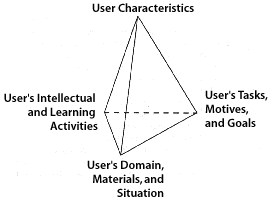User Analysis
Most writers are familiar with the process of performing an audience analysis prior to drafting a document. Performing a user analysis is not really all that different from performing a reader analysis, except that writers will need to turn their attention away from the information provided in the text to focus on the methods by which the user will access, navigate through, and interact with the computer system.Some writers find it helpful to categorize and organize the types of questions they need to ask about their readers. Doing so highlights the variety of information the writer needs to obtain before the process of writing can begin. For example, Linda Flower suggests that the first step of audience analysis is to determine the reader's knowledge, attitudes, and needs. ( Flower 1980 )
Similar categorizations exist to assist interface designers in discovering relevant information about potential users. One helpful model of user interactions with hypermedia systems has been provided by Peter Michael Fischer and Heinz Mandl. The following tetrahedral model demonstrates the interaction and interdependence of information about the user's characteristics, the user's tasks, motives, and goals, the user's domain, materials, and situation, and the user's intellectual and learning activities.

(
adapted from Fischer and Mandl, 1990
)
User's Characteristics
Interface designers ask the same kinds of questions
about how the the user will interact with the computer
system as writers ask about how the reader will
interpret the text. Designers need to know who the
intended user is and what relevant characteristics
should be considered. Writers for the WWW can use
their user analyses to shape how their texts are presented
and how the user navigates through the material.
Possible questions to ask about users include:
- Are users comfortable with using a computer system?
- Are users familiar with hypertext/hypermedia systems in general and the WWW in particular?
- Do users enjoy using the WWW as an information resource?
- Do users have any preconceptions about using the WWW as an information resource?
Writers and designers for the WWW need to be particularly aware of why the user has turned to the WWW as an information resource. Supporting all kinds of users with all kinds of tasks, motivations, and goals is a difficult but important aspect of good interface design for the WWW. Despite the fact that the nature of the medium makes it difficult to determine the needs of every potential user, it is still helpful to consider the following questions:
- What are users trying to do? Are they trying to explore the WWW in general or to collect information on a particular topic? Do they want to answer a specific question or acquire a new skill?
- Are users motivated to use the WWW as an information resource? If so, how?
- Do users have a goal?
- How will users know when the goal is met?
As difficult as it can be to specify the tasks and goals of a variety of users, it is even more difficult to specify how users will access a site. Designers cannot know with what browser or operating system a user will look at their information. However, writers and designers still need to ask the following questions about the conditions under which the user works, if only to make it clear how little can be known about these conditions.
- Will users be working from school, home, work, or someplace else?
- Will there be external distractions like noise or other work responsibilities which will interfere with users' concentration and short-term memory?
- Will users view the document from primarily one browser running under one operating system? Or will a variety of browsers and operating systems be used?
- Will users have fast or slow connections? Will users be pressed for time or leisurely?
- Will any users have special considerations which will affect how they access and view the document, like color-blindness or limited mobility?
Writers and designers might consider the mindset with which the user approaches the material and the interface. Users who are creative, curious, and daring will approach the WWW differently from those who are uncomfortable using computers and fear seeming incompetent.
The WWW also provides an excellent opportunity to explore theories of multiple representations, which claim that people learn more effectively when information is provided in a variety of media. Writers for the WWW can present information through images, sound, and even video along with the text. Asking some questions about users' intellectual and learning activities can improve the quality of the interface design.
- Will users be eager to explore the WWW or nervous about this new method of communication?
- Will users be actively engaged in the process of learning about a particular subject?
- Will users be impressed and delighted with the multimedia aspects of the WWW, or will they be frustrated with long download times?
- Can this document better meet the needs of users by presenting information in a variety of media?
